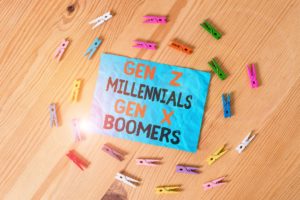By Francesca Saldan, M.A., museum curator
 For the first time, there are five generations in the workplace. Traditionalists, Baby Boomers, Gen-Xers, Millennials, and Gen-Zers can now be found working together, with new generations stepping into leadership positions. This has created an increasingly complicated work environment. COVID-19 has not only exacerbated these complications but has turned the entire arts and culture sector upside down.
For the first time, there are five generations in the workplace. Traditionalists, Baby Boomers, Gen-Xers, Millennials, and Gen-Zers can now be found working together, with new generations stepping into leadership positions. This has created an increasingly complicated work environment. COVID-19 has not only exacerbated these complications but has turned the entire arts and culture sector upside down.
I, myself, am Millennial. Like many Millennials, I work within a multi-generational workplace and am the youngest person on senior staff. My story is not unique; it does, however, highlight a common experience felt by many young leaders: being viewed as young and savvy but also the most inexperienced person at the table. For several years, generation bias has been a hurdle that has shaped my experience within leadership. And for many of my more senior colleagues it has been something that has shaped theirs—positioning them as authority figures but also stereotyping them as individuals that are out of touch and averse to challenging the status quo.
Cue COVID-19. I remember the day that my staff and I were told about the pandemic. Our executive director said that we would be closing for just two weeks. Little did we know, the pandemic would become our reality for the next year and half. Many museums, like my own, were stranded at a crossroads with no playbook to fall back on and no “best practices” to turn to on how to respond. In this way, COVID-19 created a level playing field, at least in terms of leadership. Now any idea put forth by either senior and more novice leaders holds the same amount of merit. This has created a unique opportunity for inter-generational collaboration, where “perceived experience” is no longer currency.
But there are two sides to every coin. While Boomers, Gen-Xers and Millennials are now coming to the table as equals, generational stereotypes continue to be reinforced. With many of our organizations being forced to pivot into existing only virtually, younger employees have been tasked with taking on digital engagement and social media because of a perceived strength in digital literacy. Cancellation of many fundraisers and private rentals has also financially compromised many museums, which has resulted in historic layoffs and furloughs of front line staff. In some cases, this has pitted older and younger generations of workers against one another, as staff debate the most viable and ethical ways to remain financially solvent during such uncertain times.
The murders of George Floyd, Breonna Taylor, Ahmaud Arbery and so many others created another tipping point for the industry. As most museums were at their peak output on social media, these murders shook the nation, and the world. And museums were put center stage for a response. Many younger leaders, like myself, assumed that their Boomer colleagues would opt for a more conservative, neutral statement. Or worse, no statement at all. It is my hope that many museum leaders, like myself, were pleasantly surprised by their coworkers’ stance against museum neutrality. However, I am sure that for many others these difficult conversations reinforced negative stereotypes and continue to perpetuate them.
So where do we go from here?
I think it is important to call out generational bias as another toxic –ism plaguing our industry. Like racism and sexism, ageism is keeping many of our organizations from reaching our fullest potential for community impact. It is only through being open and receptive to ideas – whether it comes from someone labeled as young and “inexperienced” or someone perceived as older and “out of touch” – that we can move forward as an industry. But it’s not just about keeping an open mind. We must also be willing to take actionable steps to better understand our co-workers as individuals – how do they tick and what are their strengths? Only then will we be able to break the cycle of making assumptions based on age.
COVID-19 has brought devastation to the world we once knew, and it has held a mirror up to each of us and our industry as a whole—illuminating our biases, faults, and strengths. And while we may never get back to “normal,” I believe that we are on path to a brighter future if we remain willing to listen and learn from the unique experiences every generation brings to the table.
CLIR’s COVID (Re)Collections series explores responses to the COVID-19 pandemic by library, cultural heritage, and information professionals. Stories are proposed by the authors/contributors and reflect their personal experiences and perspectives at the time of submission. Learn more about the series and share your own story here.

